Como fazer um sistema cicloviário, parte dois. Ou melhor, como fazer a transformação de uma grande cidade, uma das mais importantes do mundo, uma das bases do mercado financeiro mundial. Depois de NY e Paris, desta vez Londres dá o exemplo de como fazer uma rota principal. O processo de construção da ideia é parecido com o que temos estabelecido por lei aqui no Brasil, mas sem as nossas burocracias. É feita consulta popular e rapidamente aparecem propostas, todas realistas, umas viáveis, outras sonhadoras. A opção final é eleita sem delongas. O prazo e custo da obra é definido realisticamente e provavelmente serão cumpridos a risca, vide o invejável exemplo que Londres deu nas Olimpíadas. Até a 'de zeen magazine', uma das principais publicações de desenho industrial, arquitetura, urbanismo de ponta, publicou artigo com ilustrações sobre a proposta/projeto da super ciclovia expressa (numa tradução porca).
Abaixo está publicado textos, artigos e ilustrações, mas vale a pena mesmo entrar nos links, xeretear os originais, dar uma olhada de como deveríamos fazer as coisas.
Abaixo está publicado textos, artigos e ilustrações, mas vale a pena mesmo entrar nos links, xeretear os originais, dar uma olhada de como deveríamos fazer as coisas.
Aqui você pode ver a chamada pública do departamento de transporte de Londres:Transport for London - Cycle Superhighway consultations http://www.tfl.gov.uk/campaign/cycle-superhighway-consultations___________________________________________________Grist.Org
Grist.Org - London is building Europe’s longest bike superhighway

London is building Europe’s longest bike superhighway on 28 Jan 2015 3 comments
Something seriously newsworthy is happening in London — and no, it has nothing to do with Lady Cora’s affair with that creepy art critic, sorry. Yesterday, London mayor Boris Johnson approved what is said to be Europe’s longest “segregated” bike lane.Segregated bike lanes — what we here in the states would call “protected” lanes — are anything but unequal. The idea is basically to give motorists and bikers proportionate breathing room. It is designed to offer a safer alternative to auto-dominated roadways after a number of cyclist casualties along city roads in recent years. Here’s De Zeen with a word from London’s transport chief:
“Cycling is clearly now a major transport option in London, with over 170,000 bike journeys now made across central London every single day,” said Peter Hendy, transport commissioner for London. “These projects will help transform cycling in London — making it safer and an option that more and more people can enjoy.”
The lane will extend from east to west London, with another north-south route in the works as well. According to The Guardian, the project will cost upwards of a billion dollars (£900 million), and will stretch approximately 18 miles directly through the center of London. Other segregated bike paths have popped up near London in recent years, but a route of this magnitude in an urban environment is unprecedented. The Guardian‘s bike blogger, Peter Walker, visited other segregated bike lanes to report on their effect on the community:The effect is humanizing, civilizing, relaxing, enchanting. It makes the city immediately more appealing. Beyond all that it also rebuts the perennial complaint that the push for London bike routes is the niche hobby horse of a small coterie of middle-class, male cyclists. The whole point is that if you create safer cycling you necessarily create more inclusive cycling.
The route will be another step toward declogging London’s roads. Twelve years ago, the city implemented a congestion pricing tool to limit automobiles in certain areas, charging a fee for access. (Other cities, like NYC back in Blomberg’s day, have tried to jump-start similar programs, but most have crashed and burned.)“Getting more people on their bikes will reduce pressure on the road, bus and rail networks, cut pollution, and improve life for everyone, whether or not they cycle themselves,” Mayor Johnson told London 24.The proposal is currently awaiting approval from Transport for London, which will hopefully come during a Feb. 4 meeting. If it’s given the green light, construction will get rolling April, and the lane will open spring of 2016. We’d drink (tea) to that.
Share
Tweet
________________________________________________________
de zeen magazine
| 5 comments
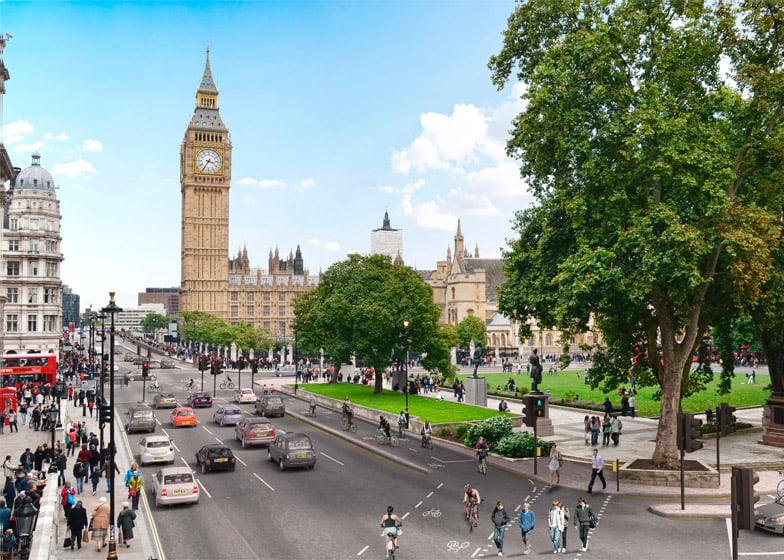
Previous
Next
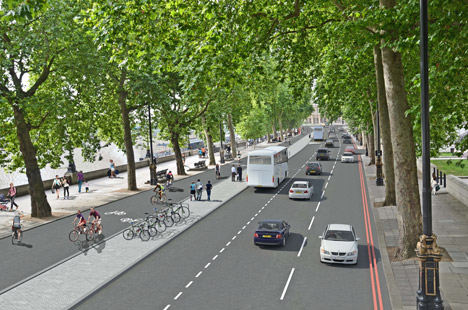
Grist.Org - London is building Europe’s longest bike superhighway

London is building Europe’s longest bike superhighway on 28 Jan 2015 3 comments
Something seriously newsworthy is happening in London — and no, it has nothing to do with Lady Cora’s affair with that creepy art critic, sorry. Yesterday, London mayor Boris Johnson approved what is said to be Europe’s longest “segregated” bike lane.Segregated bike lanes — what we here in the states would call “protected” lanes — are anything but unequal. The idea is basically to give motorists and bikers proportionate breathing room. It is designed to offer a safer alternative to auto-dominated roadways after a number of cyclist casualties along city roads in recent years. Here’s De Zeen with a word from London’s transport chief:
“Cycling is clearly now a major transport option in London, with over 170,000 bike journeys now made across central London every single day,” said Peter Hendy, transport commissioner for London. “These projects will help transform cycling in London — making it safer and an option that more and more people can enjoy.”
The lane will extend from east to west London, with another north-south route in the works as well. According to The Guardian, the project will cost upwards of a billion dollars (£900 million), and will stretch approximately 18 miles directly through the center of London. Other segregated bike paths have popped up near London in recent years, but a route of this magnitude in an urban environment is unprecedented. The Guardian‘s bike blogger, Peter Walker, visited other segregated bike lanes to report on their effect on the community:The effect is humanizing, civilizing, relaxing, enchanting. It makes the city immediately more appealing. Beyond all that it also rebuts the perennial complaint that the push for London bike routes is the niche hobby horse of a small coterie of middle-class, male cyclists. The whole point is that if you create safer cycling you necessarily create more inclusive cycling.
The route will be another step toward declogging London’s roads. Twelve years ago, the city implemented a congestion pricing tool to limit automobiles in certain areas, charging a fee for access. (Other cities, like NYC back in Blomberg’s day, have tried to jump-start similar programs, but most have crashed and burned.)“Getting more people on their bikes will reduce pressure on the road, bus and rail networks, cut pollution, and improve life for everyone, whether or not they cycle themselves,” Mayor Johnson told London 24.The proposal is currently awaiting approval from Transport for London, which will hopefully come during a Feb. 4 meeting. If it’s given the green light, construction will get rolling April, and the lane will open spring of 2016. We’d drink (tea) to that.
Share
Tweet
________________________________________________________
de zeen magazine
| 5 comments

Previous
Next

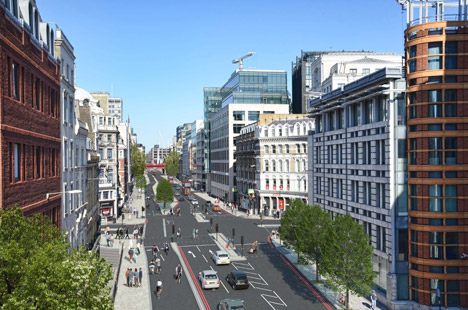
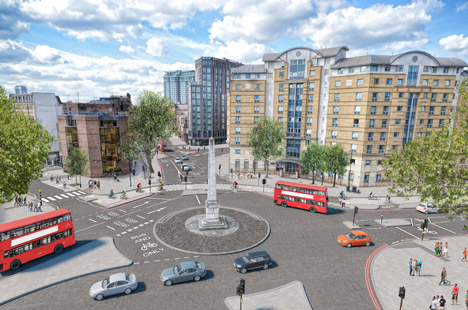
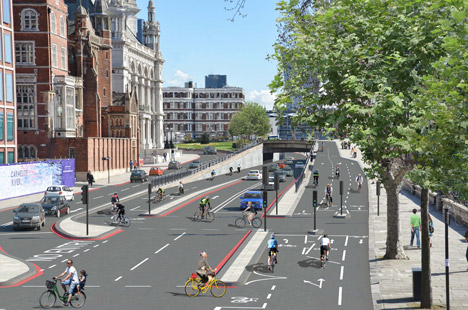
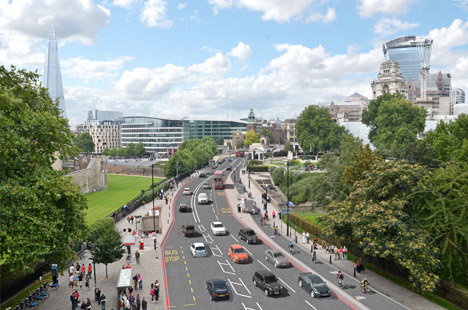

Related story: Floating cycle path proposed for London's River Thames
Something seriously newsworthy is happening in London — and no, it has nothing to do with Lady Cora’s affair with that creepy art critic, sorry. Yesterday, London mayor Boris Johnson approved what is said to be Europe’s longest “segregated” bike lane.
Segregated bike lanes — what we here in the states would call “protected” lanes — are anything but unequal. The idea is basically to give motorists and bikers proportionate breathing room. It is designed to offer a safer alternative to auto-dominated roadways after a number of cyclist casualties along city roads in recent years. Here’s De Zeen with a word from London’s transport chief:
“Cycling is clearly now a major transport option in London, with over 170,000 bike journeys now made across central London every single day,” said Peter Hendy, transport commissioner for London. “These projects will help transform cycling in London — making it safer and an option that more and more people can enjoy.”
The lane will extend from east to west London, with another north-south route in the works as well. According to The Guardian, the project will cost upwards of a billion dollars (£900 million), and will stretch approximately 18 miles directly through the center of London. Other segregated bike paths have popped up near London in recent years, but a route of this magnitude in an urban environment is unprecedented. The Guardian‘s bike blogger, Peter Walker, visited other segregated bike lanes to report on their effect on the community:
The effect is humanizing, civilizing, relaxing, enchanting. It makes the city immediately more appealing. Beyond all that it also rebuts the perennial complaint that the push for London bike routes is the niche hobby horse of a small coterie of middle-class, male cyclists. The whole point is that if you create safer cycling you necessarily create more inclusive cycling.
The route will be another step toward declogging London’s roads. Twelve years ago, the city implemented a congestion pricing tool to limit automobiles in certain areas, charging a fee for access. (Other cities, like NYC back in Blomberg’s day, have tried to jump-start similar programs, but most have crashed and burned.)
“Getting more people on their bikes will reduce pressure on the road, bus and rail networks, cut pollution, and improve life for everyone, whether or not they cycle themselves,” Mayor Johnson told London 24.
The proposal is currently awaiting approval from Transport for London, which will hopefully come during a Feb. 4 meeting. If it’s given the green light, construction will get rolling April, and the lane will open spring of 2016. We’d drink (tea) to that
News: London mayor Boris Johnson has approved plans to create Europe's longest segregated cycle lane through the city centre.
Today Johnson gave the go ahead for an amended plan to create a cycle link between east and west London, but also promised that the anticipated delays to motorist's journeys along the route will be minimised.
The revised plan will create a single dedicated cycle superhighway with a curb-segregated lane and junctions, running along the Victoria Embankment to link Tower Hill and Paddington.
The scheme forms part of Transport for London's cycle design guidelines published earlier this month, which set out standards to help make London more cycle friendly.
Original proposals for the east-west link (pictured) involved removing one of the westbound traffic lanes along Embankment. This drew concerns over increased congestion and lengthened cross-city journey times from organisations including London First, London Travelwatch, City of London, Canary Wharf and the London Taxi Drivers Association.
The worst case increase in journey time for drivers from Limehouse Link to Hyde Park Corner was predicted to be 16 minutes by traffic modelling figures.
Following lengthy consultations, the new proposal for a single, thinner lane along the same stretch of road is anticipated to reduce delays to six minutes at peak morning times.
"Thanks to the skill of TFL's engineers and traffic managers, we have made changes to our original plans which keep the whole of the segregated cycle track and junctions, while taking out much less of the route's motor traffic capacity – and so causing much shorter delays," said Johnson.
Currently awaiting approval from the TFL Board – expected 4 February – the £41 million central section of the cycle route could start construction this April. Completion is scheduled for spring 2016.
The proposal is backed by companies including Royal Bank of Scotland, Deloitte, Orange and Unilever, as well as the UK's National Health Service (NHS), following a number of cyclist deaths on the city's roads.
"Cycling is clearly now a major transport option in London, with over 170,000 bike journeys now made across central London every single day," said Peter Hendy, transport commissioner for London. "These projects will help transform cycling in London – making it safer and an option that more and more people can enjoy."
The east-west link, which will eventually provide a continuous route between Barking and Acton, is part of a wider upgrade to London's cycling infrastructure awaiting approval from the board.
This includes a north-south route that would connect King's Cross with Elephant and Castle, planned to begin 4 March, and work to upgrade the CS2 trail between Stratford and Aldgate, starting as early as 9 February.
TFL's cycle design guidelines also dictate the amount bicycle parking provision in new developments – which Foster + Partners' 250 City Road complex has exceeded by offering one bike space per bedroom.
Norman Foster put forward his own proposals to improve London's cycling infrastructure last year, unveiling plans for a network of elevated pathways above the city's railways. Other bike-friendly schemes mooted for the UK capital include a floating cycle path along the River Thames.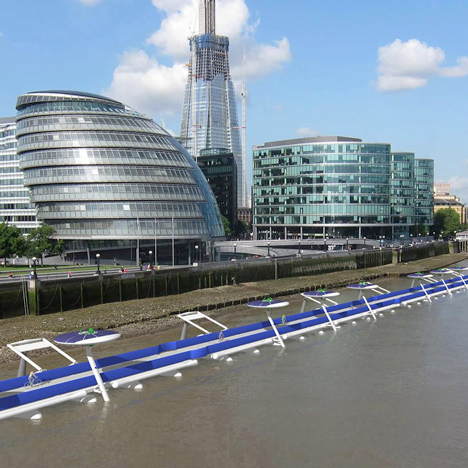

Nenhum comentário:
Postar um comentário